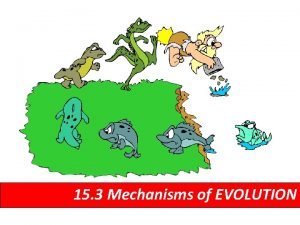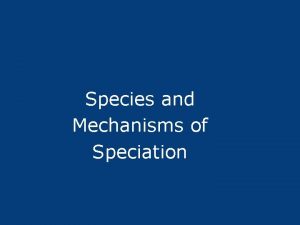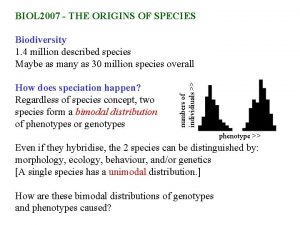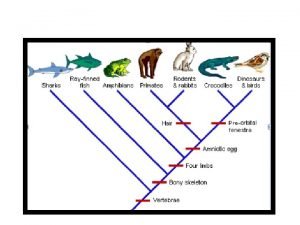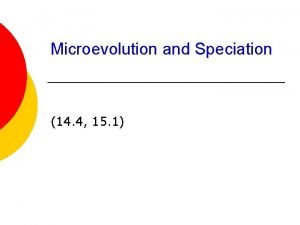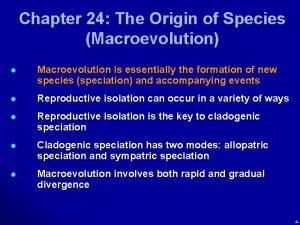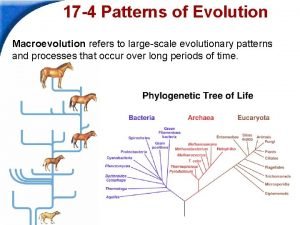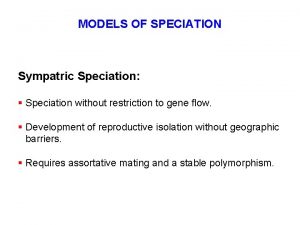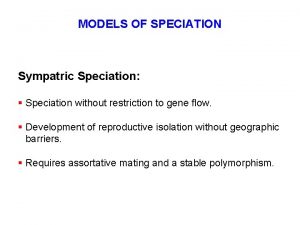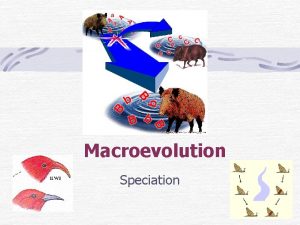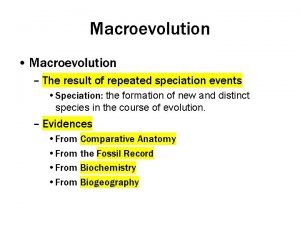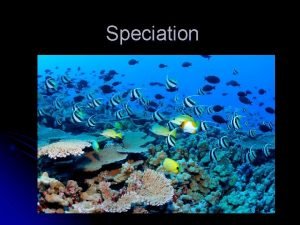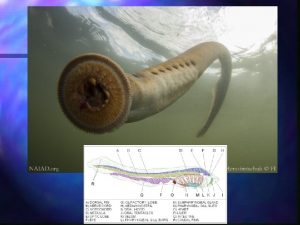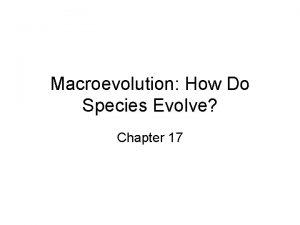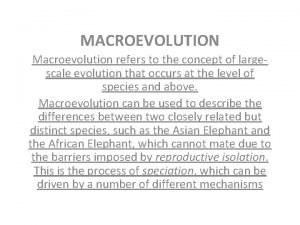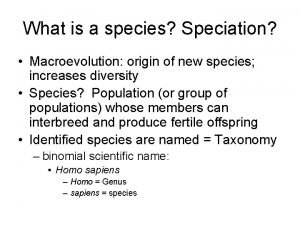Macroevolution Part III Sympatric Speciation Types of Speciation




























- Slides: 28

Macroevolution: Part III Sympatric Speciation

Types of Speciation: A Review • Allopatric speciation is the evolution of geographically isolated populations into distinct species. There is no gene flow, which tends to keep populations genetically similar. • Parapatric speciation is the evolution of geographically adjacent populations into distinct species. Divergence occurs despite limited interbreeding where the two diverging groups come into contact. • Sympatric speciation has no geographic constraint to interbreeding. • These categories are special cases of a continuum from zero (sympatric) to complete (allopatric) spatial or geographic segregation of diverging groups.

Sympatric Speciation • Sympatric Speciation occurs without geographic isolation, thus it occurs at a local level. • There is something within the environment that keeps a single species separated into two or more distinct groups. • The end result is that the two groups evolve into separate species.

Sympatric Speciation & Habitat Differentiation • Suppose that a certain species feeds on a particular host and only that host. • Next, suppose a mutation occurs that allows it to feed upon a different host. • Eventually, the species is divided into two groups that are separated from one another. Given enough time, speciation can occur. • The species of treehoppers pictured above are host specific. The first lives on bittersweet while the second lives on butternut.

The Physics of Light & Speciation • There are three primary colors of light: red, green and blue (sorted by frequency which corresponds to energy). • Water molecules tend to absorb reddish light, leaving the blue light to travel towards the depths of large bodies of water. • Because of this, deep ocean waters look blue.

The Physics of Light & Speciation • However, everything changes when the water is clouded by particles. • Just picture a silt-clogged river or lake. • Such sediment particles are particularly good at absorbing bluish light — the opposite of water molecules. • So when the sun shines on cloudy waters, blue light is present near the surface, but just a few meters down, most of the blue light will have been absorbed and mainly red light will penetrate.

The Physics of Light & Speciation • The physics of light affects not just how blue water looks to us, but how the animals living in the world's oceans, lakes, and rivers are able to find food and each other — and this, in turn, can impact their evolution. • Many fish species, for example, have evolved vision that is specifically tuned to see well in the sort of light available where they live. • But even beyond simple adaptation, the physics of light can lead to speciation.

The Physics of Light & Speciation • In fact, biologists recently demonstrated that the light penetrating to different depths of Africa's Lake Victoria seems to have played a role in promoting a massive evolutionary radiation. • More than 500 species of often brightly colored cichlid fish have evolved there in just a few hundred thousand years! • WHY? ?

The Physics of Light & Speciation • Picture a lake with slightly cloudy water. Near the surface, blue light dominates the visual environment, but in deeper waters, red light does. • A fish population lives along the lake's shore where it slopes from very shallow water to deeper water — so some of the fish spend more of their time in blue light and some spend more of their time in red light.

The Physics of Light & Speciation • Like all populations, the fish have genetic variation, individual fish have different versions of genes. • Some of this genetic variation affects the fishes' color vision. • Some fish have genes that enable them to see blue light better, while other fish have a red light advantage.

The Physics of Light & Speciation • Because of the differential penetration of light into the lake, fish sensitized to blue light have an advantage in shallower waters because they can better find food and spot predators there, while fish tuned to red light have an advantage in deeper waters. • So in different parts of the fishes' habitat, different color-sensitivity genes are favored by natural selection.

The Physics of Light & Speciation • By itself, natural selection acting on light sensitivity can cause something of a rift in the population, but when sexual selection is considered as well, the divergence is amplified. • Male fish have some variation in color. • Some males have genes for blue coloration, some have genes for red coloration. • This matters because female fish are choosy about their mates and tend to pick brightly colored males to father their offspring.

The Physics of Light & Speciation In this scenario, blue males living in deep waters would have trouble finding mates for two reasons: (1) there is little blue light around, so they look more dull than red males, and (2) the females living in deep waters tend to be less sensitive to blue light than they are to red.

The Physics of Light & Speciation • Over many generations of sexual selection acting in this way, the two parts of the population may diverge. • Though they live right next door to one another, the fish will evolve to prefer to mate with other fish that share their coloration, lightsensitivity, and habitat.

Sympatric Speciation: Habitat Differentiation and Sexual Selection

Sympatric Speciation: Polyploidy • Polyploidy refers to instant speciation which occurs in most often in plants. • Polyploid cells and organisms are those containing more than two paired (homologous) sets of chromosomes. • Polyploidy may occur due to abnormal cell division, either during mitosis, or commonly during metaphase I in meiosis.

Sympatric Speciation: Polyploidy • Autopolyploidy refers to the occurrence in which the number of chromosomes double in the offspring due to total non-disjunction during meiosis. • This was discovered by Hugo de. Vries when studying primroses. • He noticed some of them were larger and very hardy.

Sympatric Speciation: Polyploidy • The normal primrose is diploid with 14 chromosomes. 2 N = 14 • In this species there was a total nondisjunction event resulting in primroses that are tetraploid. 4 N = 28 • These primroses cannot successfully mate with the diploid species.

Sympatric Speciation: Autopolyploidy This is the mechanism for autopolyploidy. A diploid plant becomes a tetraploid plant. The offspring look very much like the diploid plant but may be a little larger and more vigorous.

Sympatric Speciation: Allopolyploidy • Allopolyploids are polyploids with chromosomes derived from different species. • Precisely, it is the result of multiplying the chromosome number in an F 1 hybrid.

Sympatric Speciation: Chromosomal Rearrangements Humans started synthesizing new species of plants in the laboratories of Sweden and Scotland during the 19 th century. Triticale was among the first synthetic plants. As a rule, triticale combines the high yield potential and good grain quality of wheat with the disease and environmental tolerance (including soil conditions) of rye.

Sympatric Speciation: Chromosomal Rearrangements In the 1960's Australian biologist M. J. D. White was studying two neighboring flightless grasshoppers. They appeared to be identical in form but showed clear differences in the configuration of their chromosomes. It appeared that there had been a random change in the chromosome structure that did not result in a lethal zygote. Those grasshoppers possessing it were more fit for certain areas of the grasshoppers' range. These are now two different species of the genera Vandiemenella.

Tempo of Evolution: Gradualism • Gradualism or phyletic gradualism is a model of evolution which theorizes that most speciation is slow, uniform and gradual. • Evolution works on large populations over an expanse of time. • The population slowly accumulate changes and evolves.

• When speciation occurred or is completed usually cannot be determined with respect to gradualism. • The seasonal isolating mechanism is a good example. Time Tempo of Evolution: Gradualism

Tempo of Evolution: Punctuated Equilibrium • Most species will exhibit little net evolutionary change for most of their geological history, remaining in an extended state called stasis. Time • Punctuated equilibrium was first proposed by Stephen Jay Gould and Niles Eldredge in 1972.

• Punctuated equilibrium occurs after some crisis in the environment. It may also be accompanied by a reduction in population size. • Once natural selection occurs and the population evolves, the population may static for long periods of time once again. Time Tempo of Evolution: Punctuated Equilibrium • The fossil record supports both of these tempo types.

Gradualism vs. Punctuated Equilibrium

Created by: Carol Leibl Science Content Director National Math and Science
 Sympatric speciation vs allopatric speciation
Sympatric speciation vs allopatric speciation Sympatric speciation example
Sympatric speciation example Parapatric speciation
Parapatric speciation Prezygotic isolating mechanisms
Prezygotic isolating mechanisms Parapatric speciation
Parapatric speciation Sympatric speciation
Sympatric speciation Examples of hybrid sterility
Examples of hybrid sterility Allopatric speciation def
Allopatric speciation def Macroevolution 7 patterns
Macroevolution 7 patterns Macroevolution 7 patterns
Macroevolution 7 patterns Macroevolution vs microevolution
Macroevolution vs microevolution Connecting the concepts: macroevolution
Connecting the concepts: macroevolution Chapter 24
Chapter 24 New concept chapter 19
New concept chapter 19 Connecting the concepts macroevolution
Connecting the concepts macroevolution What are the two major patterns of evolution?
What are the two major patterns of evolution? Hamlet act iii scene iii
Hamlet act iii scene iii Va professional standards board
Va professional standards board Addition symbol
Addition symbol Part to part ratio definition
Part to part ratio definition Part part whole
Part part whole What is technical description
What is technical description Describe the parts of a front bar?
Describe the parts of a front bar? The part of a shadow surrounding the darkest part
The part of a shadow surrounding the darkest part Part to part variation
Part to part variation Modes of speciation ppt
Modes of speciation ppt Biological species concept
Biological species concept Horizontal gene transfer
Horizontal gene transfer Speciation or the formation of new species is
Speciation or the formation of new species is


